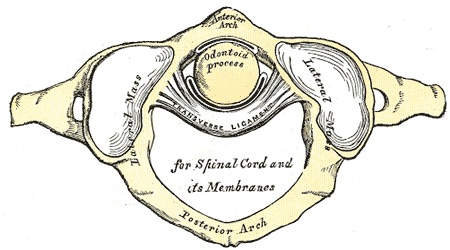Odontoid process
The axis contains the odontoid process that represents fused remnants of the atlas body, a small, toothlike, upward projection from the C2 vertebra (axis) around which the first vertebra (atlas) rotates 1).
It rises perpendicularly from the upper surface of the body. That peculiar feature gives to the vertebra a rarely used third name: vertebra dentata. In some judicial hangings the odontoid process may break and hit the medulla oblongata, causing death.
The odontoid process is held in tight approximation to the posterior aspect of the anterior arch of C1 by the transverse ligament, which stabilizes the atlantoaxial joint.
The true dimensions of the odontoid process is of paramount importance before the proper management of fractured dens using the anterior screw technique 2).
Data suggest that there are sex-specific differences with respect to measurements at the craniocervical junction (CCJ) between men and women, with women showing a more posteriorly inclined odontoid process. There were also differences between the Chiari Malformation Type 1 (CM-I) and control groups: a more acute clivus-canal angle was associated with CM-I in the adult population. These CCJ findings could have an influence on pre surgical planning 3).
Choice of oral versus endoscopic endonasal approach to the odontoid often depends on the relationship of the C1-2 complex to the hard palate. However, it is not known how this relevant anatomy changes with age.
